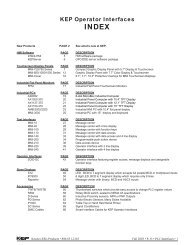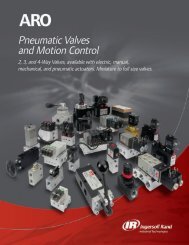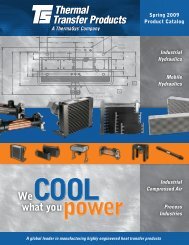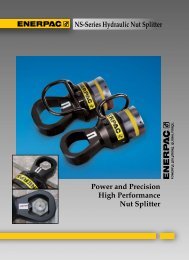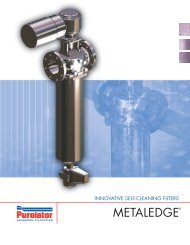Safety Guide copy - Meltric
Safety Guide copy - Meltric
Safety Guide copy - Meltric
- No tags were found...
You also want an ePaper? Increase the reach of your titles
YUMPU automatically turns print PDFs into web optimized ePapers that Google loves.
HelpingEmployersProtectWorkersfrom Arc Flash and otherElectrical Hazards
Why an Effective <strong>Safety</strong>Program is EssentialThe Hazards are RealElectrical ShocksNational <strong>Safety</strong> Council statistics show that electrical injuriesstill occur in US industry with alarming frequency:▼ 30,000 electrical shock accidents occur each year▼ 1,000 fatalities due to electrocution occur each yearRecent studies also indicate that more than half of all fatalelectrocutions occurred during routine construction, maintenance,cleaning, inspection or painting activities at industrial facilities. 1Although electrical shock accidents are frequent and electrocutionsare the fourth leading cause of industrial fatalities, few areaware of how little current is actually required to cause severeinjury or death. In this regard, even the current required to lightjust a 7 1/2 watt, 120 volt lamp is enough to cause a fatality – ifit passes across a person’s chest.1 Taylor, McGwin, Valent, Rue 2002 “Fatal Occupational Electrocutions in theUnited States” Injury Prevention 2002;8:306-312Arc Flash & Arc BlastsThe arc flash and arc blasts that occur when short circuit currentsflow through the air are violent and deadly events.Consequences of an Arc Fault Event▼ Temperatures shoot up dramatically, reaching levels 4times as hot as the sun’s surface and instantly vaporizingsurrounding components.▼ Ionized gases, molten metal from vaporized conductorsand shrapnel from damaged equipment explode throughthe air under enormous pressure.Anyone or anything in the path of an arc flash or arc blast islikely to be severely injured or damaged.Copper vapor instantlyexpands to 67,000 timesthe volume of copperBlinding light causesvision damageExpelled shrapnelcauses physicaltraumaStatistics indicate that five to ten arc flash explosions occur inelectrical equipment every day in the United States and thatthese accidents send more than 2,000 workers to burn centerswith severe injuries each year. 22Capschell, Inc.35,000°F temperaturescause severe burnsThermoacoustic shock wavescause ruptured ear drums, collapsedlungs or other fatal injuries2
It’s Your Responsibility & It’s the LawAs an official act of Congress, the Occupational <strong>Safety</strong> andHealth Act of 1970 is the law. Section 5(a) mandates thateach employer shall:1. Furnish to each of his employees employment and a placeof employment which are free from recognized hazards thatare causing or are likely to cause death or serious harm tohis employees.2. Comply with occupational safety and health standardspromulgated under the act.One of the key OSHA regulations that employers mustcomply with is 29 CFR 1910 ‘Occupational <strong>Safety</strong> & HealthStandards.’ These standards establish the legal obligationrequiring employers to proactively assess workplace hazardsand take appropriate actions to advise and protecttheir employees from the hazards.In situations where electrical injury has occurred, OSHA usescompliance with NFPA 70E as a key test in determiningwhether or not appropriate precautions have been taken. Ifthey have not been, the employer may be subject to substantialfines and management personnel may be held criminally liable.29 CFR 1910 – Occupational <strong>Safety</strong> & Health StandardsKey Electrical <strong>Safety</strong> RequirementsGeneral requirements. – 1910.1321910.132(d)(1) The employer shall assess the workplace to determine ifhazards are present, or are likely to be present, which necessitate the use ofpersonal protective equipment (PPE). If such hazards are present, or likelyto be present, the employer shall:1910.132(d)(1)(i)–(iii) Select, and have each affected employee use, thetypes of PPE that will protect the affected employee from the hazards identifiedin the hazard assessment; Communicate selection decisions to eachaffected employee; and, Select PPE that properly fits each affected employee.1910.132(f)(1)(i) The employer shall provide training to each employeewho is required by this section to use PPE.Safeguards for personnel protection. – 1910.3351910.335(a)(1)(i) Employees working in areas where there are potentialelectrical hazards shall be provided with, and shall use, electrical protectiveequipment that is appropriate for the specific parts of the body to beprotected and for the work to be performed.The Costs of Electrical Accidents can be EnormousInjury CostsWhen serious electrical accidents occur, the cost to a businessoften exceeds $1 million, and the cost to the injured person isobviously incalculable.OSHA CitationsIn 2007, OSHA issued almost 90,000 safety citations. Penaltiesfor serious violations may be ten’s or even hundred’s of thousandsof dollars, depending upon the situation.LawsuitsIn addition to the financial impacts of legal and settlementcosts, the lost time and disruption caused by the lawsuitscommon after injuries can be a significant burden.3
Key Elementsof NFPA 70EThe Standard for Electrical<strong>Safety</strong> in the WorkplaceAs the foremost consensus standard for electrical safety in the workplace, NFPA70E is the primary resource for employers to use in determining how to complywith OSHA’s electrical safety regulations. It is also used by OSHA and the courts inthe investigation of injuries in order to assess whether or not the involved employerstook reasonable steps and precautions to protect their employees.The key elements of the standard are summarized below. Complete details shouldbe obtained from the standard itself. In Canada, CSA recently published CSA Z462‘Workplace Electrical <strong>Safety</strong>’ which is based on and is harmonized with NFPA 70E.Key elements in CSA Z462 are essentially the same as those found in NFPA 70E.Article 110General Requirements for Electrical<strong>Safety</strong>–Related Work PracticesTraining Requirements (110.6)Employees who may be exposed to electrical hazards must be specifically trained tounderstand the hazards associated with electrical energy as well as the safety-relatedwork practices and procedures required to provide protection from them. The levelof training provided determines the tasks that an employee is qualified to perform.Only specially ‘Qualified Persons’ may perform work on or near exposed and energizedelectrical conductors or circuit parts. The training requirements include:National Electric CodeSection 110.16 Flash ProtectionFPN No. 1:NFPA 70E-2004, Electrical <strong>Safety</strong> in theWorkplace, provides assistance in determiningthe severity of potential exposure, planningsafe work practices, and selecting personalprotective equipment.▼ How to recognize the potential hazards that exist▼ How to distinguish energized from non-energized parts▼ How to determine the voltage of exposed energized electrica conductors▼ The relationship between the hazard and potential injury▼ How to avoid exposure to the hazards▼ How to select appropriate personal protective equipment▼ Specific work practices and procedures to be followed▼ Emergency procedures for assisting victims of electrical incidents▼ How to perform a hazard/risk analysis▼ How to determine approach and flash protection boundariesElectrical <strong>Safety</strong> Program (110.7)Employers are required to implement and document an electrical safety program todirect employee activities in a manner that is appropriate for the different voltage,energy level and circuit conditions that may be encountered. This safety programshall include all electrical safety procedures, be documented in writing, and bemade available to all employees. If work on or near energized electrical conductorsand circuit parts operating at 50V or more is required, the safety program must:4
▼ Include a procedure that defines requirements and provides guidance for workersas they perform work on or near live parts▼ Identify the hazard/risk evaluation procedure to be used before work is started withinthe limited approach boundary of energized electrical conductors and circuit partsoperating at 50 volts or more.▼ Include a job briefing process to inform employees of the hazards, proper procedures,special precautions, energy source controls and PPE requirementsWorking While Exposed to Electrical Hazards (110.8)<strong>Safety</strong> work practices consistent with the nature and extent of the associated electricalhazards shall be used to safeguard employees from injury while working on or nearexposed electrical or circuit parts that are or can become energized. Two primaryconditions are identified and addressed:(1) Energized Electrical Conductors and Circuit Parts – Safe Work Condition. Live parts towhich an employee might be exposed shall be put into an electrically safe work conditionbefore employees can work on or near them, unless work on energized components can bejustified according to section 130.1.(2) Energized Electrical Conductors and Circuit Parts – Unsafe Work Condition. Only qualifiedpersons may work on electrical conductors or circuit parts that have not been put intoan electrically safe work condition.The requirements for establishing an electrically safe work condition are indicated inArticle 120, while the requirements for work involving electrical hazards are coveredin Article 130.Article 120Establishing an Electrically Safe Work ConditionThe most effective way to prevent an electrical injury is to completely remove thesource of electrical energy and eliminate the possibility of its reappearance. To doso, workers must identify and disconnect all possible sources of electricity.Process of Achieving an Electrically Safe Work Condition (120.1)(1) Identify all possible sources of electric supply.Care should be taken to identify the possible presence of secondary sources.(2) Properly interrupt the load current(s) and open the disconnecting device(s).Not all disconnecting devices are rated to interrupt load currents; this should onlybe done with a properly rated device.(3) Verify deenergization through visual inspection of the disconnect contacts.Disconnecting means may sometimes fail to open all phase conductors when the handleis operated, so it is necessary to verify physical contact separation. If this requiresremoving the disconnect door or cover, appropriate PPE must be used.(4) Apply lockout/tagout devices.This should be done in accordance with a formally established company policy.CSA Z462Workplace Electrical <strong>Safety</strong>CSA Z462 is a Workplace Electrical <strong>Safety</strong>standard in Canada. It was published inDecember 2008 and is based on NFPA 70Eand has been harmonized with Parts I, IIand III of the Canadian Electrical Code.Visit www.ShopCSA.cato purchase a complete<strong>copy</strong> of CSA Z462.5
Key Elementsof NFPA 70EThe Standard for Electrical<strong>Safety</strong> in the WorkplaceVisit NFPA.org to purchasea complete <strong>copy</strong> of theNFPA 70E standardLimits of ApproachBefore work can begin near exposed energizedparts, approach and flash protection boundariesmust be determined.Flash protection boundaryProhibited spaceLimited approachboundaryAny point on an exposed,energized electricalconductor or circuit partRestricted approachboundaryProhibited approachboundary(5) Use a voltage detector to test each conductor to which the worker may be exposedin order to verify deenergization.The voltage detecting device must be functionally tested both before and after takingthe measurements in order to ensure that it is working satisfactorily.(6) Circuit parts with induced voltages or stored electrical energy must be grounded.If the conductors being deenergized could contact other energized conductors orcircuit parts, grounding devices rated for the available fault duty should be applied.Article 130Work Involving Electrical HazardsJustification (130.1)Deciding to work on or near energized electrical conductors and circuit parts shouldbe a last resort in the workplace, after all other opportunities for establishing anelectrically safe work condition have been exhausted. Work on energized parts at50V or more should only be performed if the employer can demonstrate thatdeenergizing will introduce additional hazards or is not feasible due to equipmentdesign or operational limitations.RWhen non-routine work must be performed on energized parts, a detailed work permitmust be prepared before the work can start. The work permit must document thefollowing elements and be approved by a responsible manager or safety officer:Flash protection boundary – distance from aprospective arc source within which a personcould receive a second degree burn if an arcflash were to occur.Limited approach boundary – distance withinwhich a shock hazard exists.Restricted approach boundary – distancewithin which there is an increased risk ofshock, due to electrical arc over combinedwith inadvertent movement.Prohibited approach boundary – distancewithin which work is considered the same asmaking contact with the electrical conductoror circuit part.▼ A description of the circuit and equipment to be worked on▼ Justification for performing the work in an energized condition▼ A description of the safe work practices to be employed▼ Results of the shock hazard analysis▼ Determination of shock protection boundaries▼ Results of the flash hazard analysis▼ The flash protection boundary▼ The personnel protective equipment required for worker safety▼ Restricted access of unqualified persons from the work area▼ Evidence that the job briefing has been completedApproach Boundaries to Energized Electrical Conductors or Circuit Parts (130.2)Limited, restricted and prohibited approach boundaries must be determined in orderto identify safe approach distances and the precautions required to minimize thepossibility of shock. These boundaries are described in the illustration in the leftmargin and can be determined from a table in the standard.6
Arc Flash Hazard Analysis (130.3)An arc flash hazard analysis shall be done in order to protect personnel from the possibilityof being injured by an arc flash. As part of this analysis, flash protectionboundaries must be determined based on available bolted fault currents and the incidentenergy exposure level for personnel working within this boundary must be calculated.Personal and Other Protective Equipment (130.7)Employees working in areas where electrical hazards are present shall be providedwith, and shall use, protective equipment that is designed and constructed for thespecific part of the body to be protected and for the work to be performed.Requirements for eye, hand, head and body protection and/or v-rated tools are determinedbased on the hazard/risk category for the work to be performed. The standardprovides a reference table indicating the hazard/risk category for many of the electricaltasks performed in industry and also provides a chart showing the protective equipmentthat is required for each hazard/risk category.The tables below show the hazard/risk categories for several common tasks anddescribe the protective equipment required for each of the categories.Selection of Personal Protective EquipmentFirst, Identify the Risk Category in NFPA 70E or CSA Z462Hazard/Risk Category Classifications by Task (abridged table)Panelboards or Switchboards Rated >240V and up to 600V Hazard/Risk CategoryCB or fused switch operation with covers on 0CB or fused switch operation with covers off 1Work on energized parts, including voltage testing 2*Other 600V Class (277V through 600V, nominal) EquipmentOpening hinged covers (to expose bare, energized parts) 1Removal of bolted covers (to expose bare, energized parts) 2*Then, Choose the Appropriate PPE for that Hazard/Risk CategoryHazard/RiskCategoryTypical Protective Clothing SystemsThe most effective means of preventingelectrical injuries is to avoid exposingemployees to live parts and the hazardsthat they present.0 Long sleeve shirt and pants plus safety glasses, hearing protection and gloves1 Arc-rated (level 4) long sleeve shirt, pants, coverall, face shield, jacket, leathergloves and work shoes2 Arc-rated (level 8) long sleeve shirt, pants, coverall, face shield, jacket, leather glovesand work shoes2* Arc-rated (level 8) suit hood, long sleeve shirt, pants, coverall, jacket, leather glovesand work shoes7
Eliminate the Hazards of Standard Plugs & Receptacles<strong>Meltric</strong> DecontactorsStandard Plugs & ReceptaclesSAFEVSHAZARDOUSPressing the pawl on the DECONTACTOR receptacle breaks the electricalconnection. The de-energized plug can then be safely withdrawn.Most traditional plugs and receptacles shouldnever be connected or disconnected under load.<strong>Meltric</strong> Decontactors are designed and rated to function as aswitch. Users can safely make and break connections, evenin overload conditions.Standard pin & sleeve and twist type plug & receptacles arenot intended to be disconnected or connected under load.Doing so can be very hazardous.✔ Silver-nickel contacts resist wear and maintain superiorconductivity even in wet and corrosive environments.✔ Decontactors silver-nickel butt-style contacts withstandarcing and resist welding, allowing them to close intoand withstand short circuit currents as high as 100kA.✔ Enclosed arc chambers and dead front constructionprevent exposure to arcing and eliminate unintendedaccess to live parts.✗✗✗The electrical properties of their brass contacts degradesignificantly with oxidation and wear from normal use.Because brass cannot withstand arcing, the contactsmay vaporize and cause an arc flash if connected ordisconnected in overload conditions.Live front designs expose users to live parts and also tothe arcing or arc blasts that may result from their use inadverse conditions.Decontactors provide a secure and foolproof means ofensuring user safety without the need for the interlocks andsafety switches required with other types of plugs & receptacles.At no time is a user exposed to live contacts whileoperating a Decontactor.Because nothing prevents these devices from being connectedand disconnected under load in many applications, users areoften exposed to these hazards. When interlocks are provided,their function is often defeated by the use of extension cords.9
Simplify NFPA 70E Compliancewith <strong>Meltric</strong>’s DECONTACTOR TM SeriesSwitch Rated Plugs & Receptacles<strong>Meltric</strong>’s DECONTACTOR TM Series switch rated plugs & receptaclessimplify compliance with NFPA 70E by eliminating the possibility ofexposure to energized parts and arcing when making andbreaking the electrical connections required to change-outmotors and other equipment. This avoids the need to takemany of the special precautions required to ensure that workersare aware of and protected from the shock and arc-flash hazardsthat exist whenever work is performed on or around energizedcircuit components.Decontactor plugs & receptacles canbe easily locked out and tagged out.Switch Ratings Simplify DeenergizationWith push button load-breaking, UL & CSA switch ratings forapplications up to 200A or 60 hp and short circuit closing &withstand ratings up to 100kA (in circuits protected with RK1current limiting fuses), Decontactors provide a safe, simple andconvenient means of disconnecting the load. There is no needfor the interlocks and auxiliary disconnects required with standardplugs and receptacles.Plug Removal Verifies DeenergizationRemoving the plug from the receptacle provides visualverification of contact separation and deenergization. Thisavoids the need for the voltage testing required with manyother disconnect switches that often involves energizedelectrical work.Dead Front Construction Ensuresa Safe Work ConditionThe Decontactors design ensures that load making andbreaking is isolated in enclosed arc chambers and that asafety shutter closes over the live receptacle contacts beforethe plug can be removed. This prevents user exposure to liveparts and arcing, and ensures that a safe work condition ismaintained. There is no need to perform hazard analysis,obtain work permits, use cumbersome PPE, or take the otherprecautions required when working on or near live parts.Specialized Electrical Personnelmay not be Required on SiteBecause there is no electrical work to be performed and noconcern about access to live parts when making and breakingconnections with <strong>Meltric</strong> Decontactors, mechanics canquickly change-out motors with pre-wired replacements.Risk Category ‘0’ EliminatesCumbersome PPEMaking and breaking electrical connections with Decontactorsis a Risk Category ‘0’ operation, so no special personalprotective equipment is required. This avoids the need to‘suit-up’ with the cumbersome PPE required.Decontactors enable quick motor change-outs10
Motor Change-out Process ComparisonQUICK & EASY<strong>Meltric</strong> DECONTACTORVSCUMBERSOMETypical Disconnect SwitchMechanics can quickly and safely make andbreak electrical connections, without special PPE.After operating the disconnect switch, a worker still needs to verifydeenergization. Exposure to live parts is inevitable, so PPE is required.1. Switch DECONTACTOR to ‘off’ position2. Remove plug from receptacle3. Apply lockout/tagout4. Remove old/install new motor5. Insert plug into receptacle✔ Change-out downtime is reduced by up to 50%.1. Switch disconnect to ‘off’ position2. Apply lockout/tagout3. Perform Shock/Arc Flash Hazard Analysis4. Obtain permit for energized electrical work5. Suit up with appropriate PPE6. Remove the disconnect switch cover7. Voltage test to verify deenergization8. Disconnect motor from hard-wiring9. Remove old/install new motor10. Connect new motor to hard wiring✔ Equipment and installation costs are reducedby eliminating the need for interlocks andsafety switches.✔ Maintenance efficiency is improved by allowingmechanics to perform change-outs. Pre-wiring canbe done at a convenient time in the electrical shopand can help ensure proper motor rotation.Decontactors can beadded to existing disconnectsto avoid PPE requirementsfor voltage testing.11
Make & Break Electrical ConnectionsSimply, Safely & in Compliance with NFPA 70EUse <strong>Meltric</strong> DECONTACTOR TM SeriesSwitch Rated Plugs & ReceptaclesDSN20-60AUp to 20 hpDS• Compact, lightweight design• NEMA 4X, IP66/IP67• Up to 4 auxiliary contacts• Polyester casings• 100kA + short circuit rated20-200AUp to 25 hp• Rugged construction• NEMA 3R• Up to 5 auxiliary contacts• Polyester or Metal casings• ≥65kA + short circuit ratedDB30-100AUp to 60 hp• High horsepower capacity• IP67• Up to 4 auxiliary contacts• Zinc aluminum alloy casings• 100kA + short circuit rated+ Testing was performed with RK1 current limiting fuses sized at 400% of the highest full load motor ampacity associatedwith the devices hp ratings, except for DB100 which was tested with 250A fuses. Non-horsepower rated DS100and DS200 devices were tested with RK5 time delay fuses sized at 100% of the devices rated ampacity.▼▼▼UL & CSA Listed:UL 1682UL Subject 2682CSA C22.2 No. 182.1UL & CSA Switch Rated perUL Subject 2682 & Listed for:Motor Circuit Disconnect SwitchingBranch Circuit Disconnect SwitchingShort Circuit RatedUp to 100kA closing & withstandwith RK1 current limiting fusesUpdate existingequipment easily withstandard <strong>Meltric</strong>Adapter PlatesExisting back box<strong>Meltric</strong> Adapter PlatesDECONTACTOR TMSeries Switch RatedPlug & ReceptacleContact <strong>Meltric</strong> or your <strong>Meltric</strong> salesrepresentative for more information aboutDecontactor Series Plugs and Receptacles.Presented by <strong>Meltric</strong> and:4640 Ironwood Drive • Franklin, WI 53132800.433.7642 • Fax 414.817.6161www.meltric.com12 SAFETYGUIDE 060506 C




